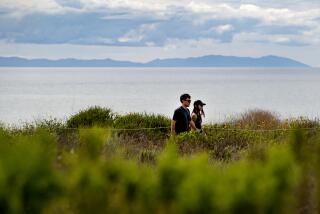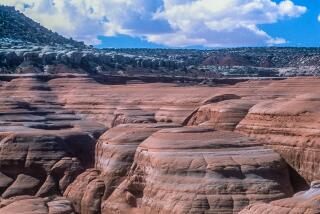‘The National Parks: America’s Best Idea’ by Dayton Duncan and Ken Burns
- Share via
Ours is a house divided -- not by red and blue states but by something more essential: our relationship to what’s wild. Should we leave it alone? Cherish it and make sure it lasts? Or continue to wall it up, fence it off and take shiny things from it so we can all get rich?
Fortunately, citizens such as John Muir, George Bird Grinnell and Marjory Stoneman Douglas have had the courage and foresight to battle for preservation of what was once commonly known as “scenery.” The wilderness had them at hello; they understood that we need the beauty and solitude of open space.
And this they also knew: that the days of the wilderness were numbered. So they dedicated themselves to saving places such as Yosemite, Yellowstone and the Everglades, and for the first time in the history of humankind, certain lands were set aside as national parks -- for everyone, not just the aristocracy.
In “The National Parks: America’s Best Idea” -- the subtitle comes from Wallace Stegner’s famous and accurate observation -- Dayton Duncan and Ken Burns pay homage to these crown jewels and the people who fought for them. Their 12-hour series debuts on PBS on Sunday night, and they have also put together a hefty and enlightening companion book.
Both projects come not a moment too soon, for our open spaces are once again under siege. A new law permits concealed and loaded guns in national parks -- which many rangers fear will lead to increased wildlife poaching.
This is not what the parks’ founders had in mind: Theirs was a crusade for connection. As historian William Cronon tells Duncan and Burns, “In the parks, we experience the immensity . . . of time which is the creation itself . . . and yet it is also time shared with the people that we visit these places with.” That makes for an “intimate transmission from generation to generation to generation of the love of place, the love of nation, that the national parks are meant to stand for.”
Told chronologically, through the stories of key players in the fight for wilderness preservation, “The National Parks” takes us from the first discussions of the park system in the 1860s to the dilemmas of the present day. In the early years of Yellowstone, the situation was so precarious that the Army was called in. Later, as the fight to protect other regions heated up, game wardens lost their lives.
And yet, in the book at least, this sweep of history is favored over the intimacy to which Cronon refers. Outside of a series of wonderful sidebars, and a brief look at Muir’s flight from a violent father to the high Sierras, the authors never fully explore how their cast of characters connected with the land. Of Capt. Charles Young, the son of an escaped slave, leader of a cavalry charge against Pancho Villa and the first black man to be put in charge of a national park, they note simply: “His troops adored him.”
But what must Young have thought about Sequoia National Park as he led his men up Mt. Whitney to build the first trail? How did the ancient pueblo site of Mesa Verde resonate for the Wetherell brothers when they first laid eyes on it? Exactly what about the Everglades rang Douglas’ chimes?
Alas, in these pages, we do not feel the thing that compelled a singular parade of citizens to preserve these open spaces. “The National Parks” is a firm and sincere handshake, rather than an embrace.
Still, the authors’ painstaking assembly of lost stories and unsung heroes, along with their reverence for our natural heritage, render their book a necessary addition to the extensive library of national parks literature -- at a critical moment for America’s best idea.
Stillman is the author of “Joshua Tree: Desolation Tango,” among other books.
More to Read
The biggest entertainment stories
Get our big stories about Hollywood, film, television, music, arts, culture and more right in your inbox as soon as they publish.
You may occasionally receive promotional content from the Los Angeles Times.










